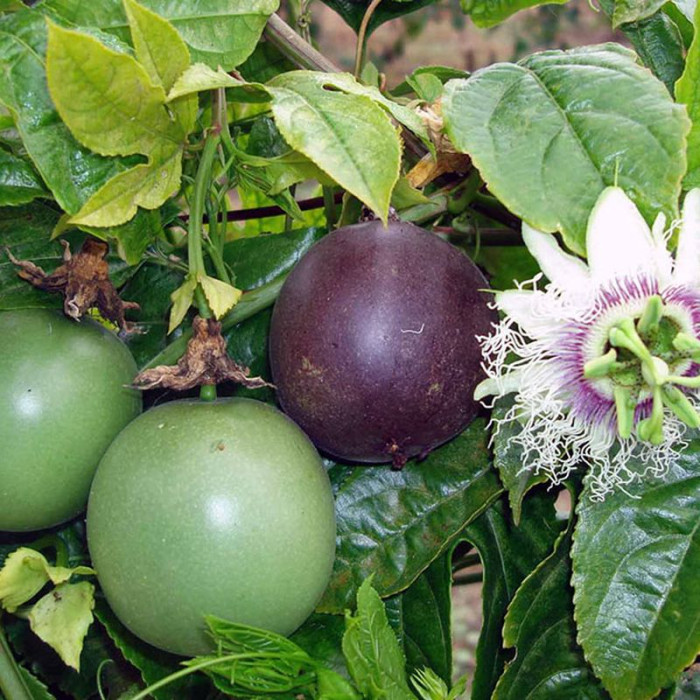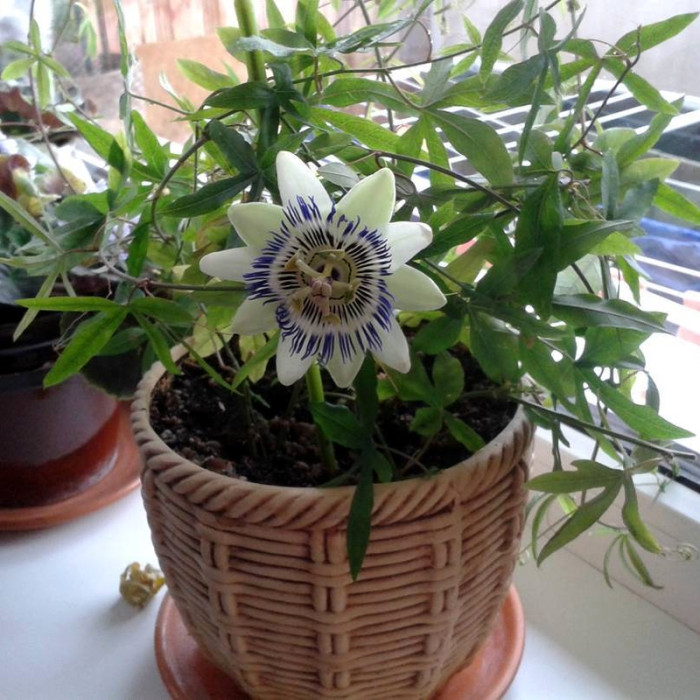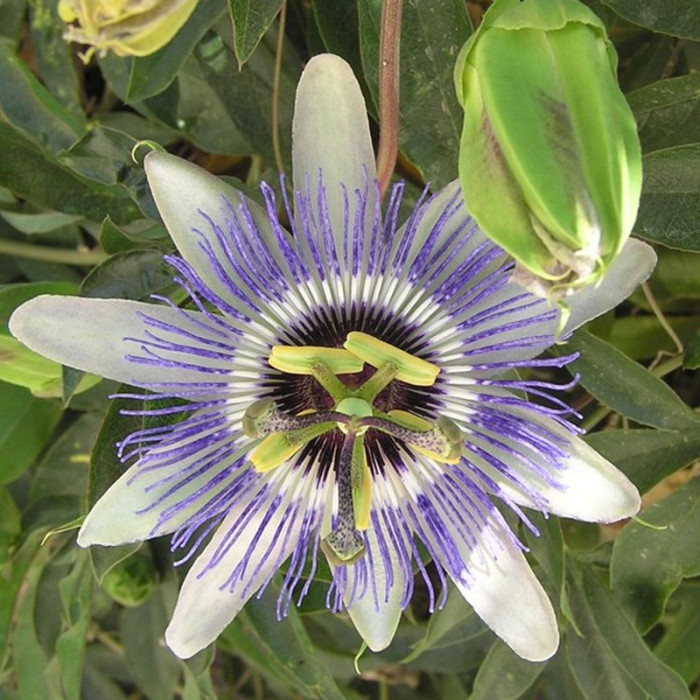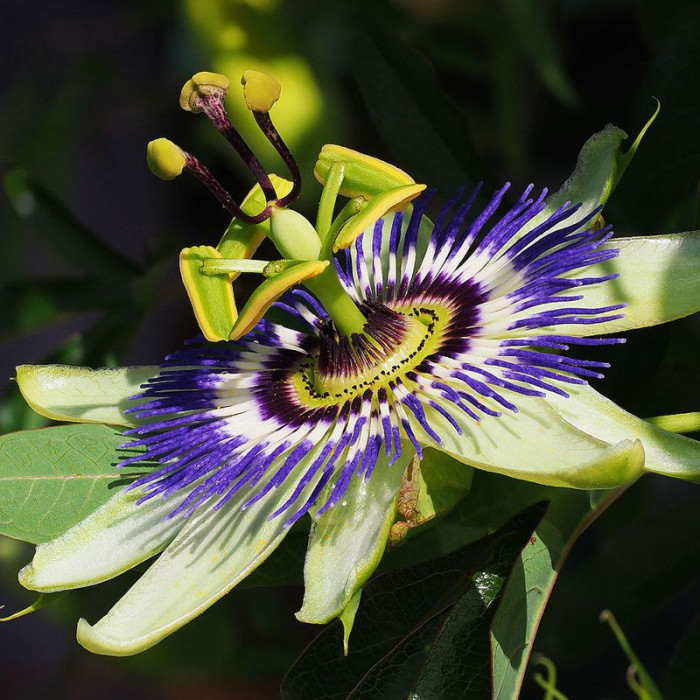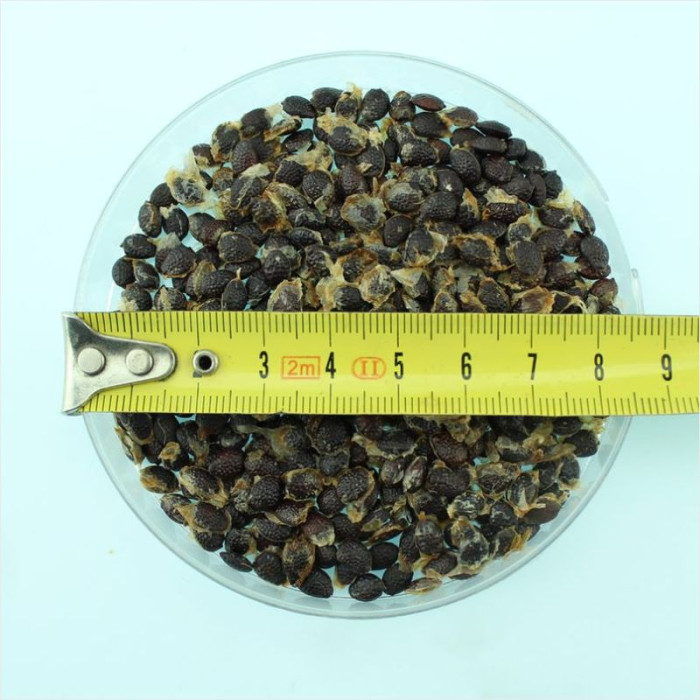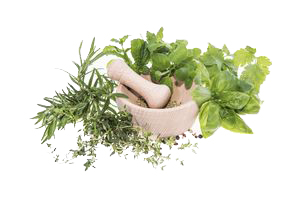Maypop, purple passionflower, true passionflower, wild apricot, and wild passion vine / Passiflora incarnata - a herbaceous vine with a climbing stem up to 9 m long. Long horizontal rhizomes develop underground, from the dormant buds of which new above-ground leafy or underground shoots arise.
The leaves are alternate, deeply tripartite, with a finely serrated edge, up to 20 cm in diameter, sitting on long petioles. Tendrils develop in the leaf axils.
The flowers are large, solitary, up to 7-9 cm in diameter, sitting on long peduncles, with five sepals. Sepals lanceolate, leathery, with spiny outgrowths at the apex. The corolla consists of five free petals and a "crown" consisting of two rings of filiform fringes, like the petals, which are bright purple in color. Such a peculiar structure of the corolla led to another name for the plant: «Cavalier Star».
The fruit is a greenish-yellow berry that falls when ripe. Herbaceous parts of the plant contain 0.5% harmane, harmine and harmol, which are indole alkaloids. It also contains flavonoids (vitexin, quercetin, apigenin, luteolin), coumarins and quinones. The jelly-like pulp of the fruit is edible and is used to make jellies and jams.
Herbaceous stems of the plant (lat. Herba Passiflorae) 50-60 cm long, cut off during flowering and the formation of immature fruits, have medicinal value. They have a slight odor and a bitter taste. The raw materials are crushed and dried at a temperature of 50-60 °C.
Herbaceous parts of the plant are used in modern medicine for the preparation of medicines (most often a liquid extract) that have a sedative and mild hypnotic effect on the central nervous system for neurasthenia, insomnia, chronic alcoholism, and menopausal disorders.
Passionflower corporal is the most valuable in the family of passionflowers, because it is both an ornamental, fruit and medicinal plant.
Surely many are familiar with the name "passiflora extract". This drug is made from the aerial part of the corporal passionflower and has a calming effect in various diseases of the cardiovascular system, but is contraindicated in atherosclerosis. The fruits are the size of an average plum, with a thin soft skin, green, vaguely reminiscent of pineapple in taste, but still with a strong smell of freshness, contain a lot of ascorbic acid.
Cultivation of corporal passionflower (Passiflora incarnata)
Sowing should be done in a specially prepared mixture of peat, earth from a deciduous forest, clay in equal amounts, plus mineral fertilizers and a small amount of chalk.
The substrate for growing seedlings from seeds is moisture-intensive and nutritious, passionflower roots breathe in it. They should be buried to a depth of 1 cm (no more!), then covered with a cap or spunbond to create a greenhouse effect and make sure that the soil is constantly moist.
Coconut or peat tablets are even more suitable for seed germination. Sowing seeds one per tablet. At a temperature of 23-27 degrees, they sprout together within a month. Do not rush to get upset if after 30 days there are no sprouts - wait another 2 months. Some experts report that passionflower can sprout six months after sowing.
As soon as the sprouts have hatched from the ground, the cap must be removed immediately in order to avoid disease with a black leg. Young plants should be sprayed at least once a day from a spray bottle.
When the sprout reaches 7-8 cm, it is worth putting a support. Further growth will be very active and by the end of the first season, with proper care and periodic fertilizing with fertilizers for flower crops, the length of the shoots can reach 1.5-1.8 meters, and the plant itself will bloom. The shoots are flexible and can be grown on a support, onto which they can be carefully wrapped as you please.
It is not necessary to stratify the seeds (influence by low temperatures). Passiflora in nature is never exposed to temperatures below 5 degrees, and the optimum for seed germination and development of young plants is within 10-15 ° C at night and 20-25 ° C during the day with slight fluctuations during the day and seasons. Moisture-loving, undemanding to the soil. When the temperature rises above 28 ° C, they begin to feel discomfort, and at 30 ° C and higher temperatures, the leaves can get burned, the buds crumble and plant growth stops. If the heat is accompanied by wind, the death of plants is generally possible.
Passiflora can also be propagated by cuttings. When propagated by seed, passionflower bodily can give splitting, i.e. daughter plants may differ from parent plants in a number of ways. This allows plant breeding in the desired direction. For example, plants are selected on the basis of large-fruitedness and precocity. Young plants need to be well watered at first, and when they get stronger, drought resistance increases. If the soil is fertile enough and the plants grow well, then you can not feed them at all, and if the soil is poor, then you can feed it with a solution of any complex mineral fertilizer in small doses.
Passionflower - drought-resistant, but in drought there are many sterile flowers that do not form fruits. In this regard, moisture supply should be optimal. If it is necessary to produce fruits, then it is imperative to have another clone to ensure cross-pollination. In the open ground, pollination is carried out by bees and bumblebees, and they like the flowers of this species much more than the flowers of blue passionflower. Passiflora flesh-colored is a good honey plant. It blooms profusely and for a long time, from June to October, the peak of flowering occurs in August.
The fruits ripen gradually in September-November. The sweetest fruits are at the very beginning of ripening. A concentrated juice is obtained from the pulp, which can be stored in the refrigerator for a very long time (almost until May) without canning. During storage, the juice is diluted with water, sugar syrup is added to taste, thus obtaining a very aromatic drink. The diluted drink does not have a long shelf life and it is advisable to use it on the day of preparation.

No questions about this product, be the first and ask your question.


